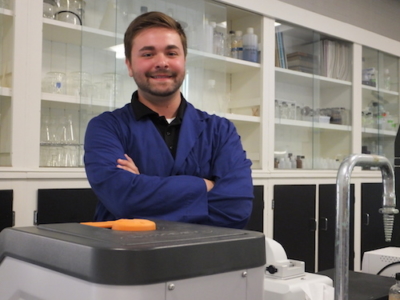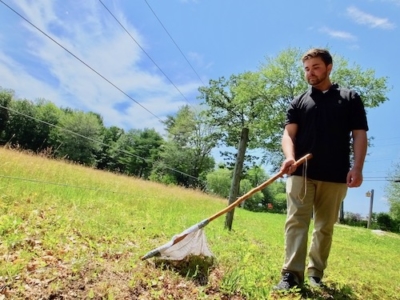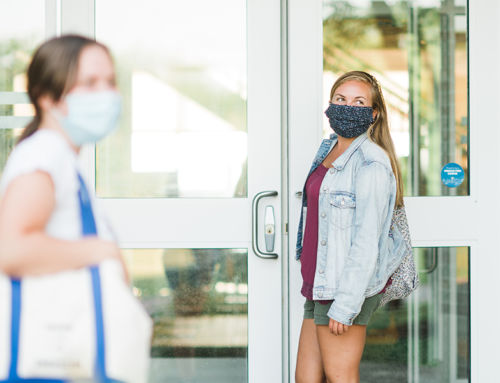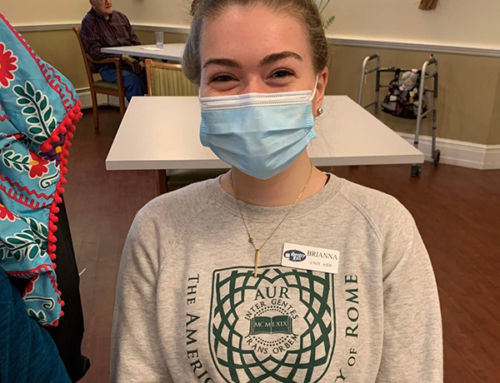Summer in Maine means pleasant days by the lake, scenic strolls through the woods, and evening bonfires with friends. It’s a time when tourists and year-round residents alike seek to spend as much time as possible outside. It’s also a time of year when public health concerns rise concerning the creeping, crawling arachnids you sometimes feel moving up your leg or across your arm: ticks.
Enter Erick Schadler, resident of Raymond, Maine, and rising senior at Saint Joseph’s College in Standish. Erick pursued a summer research project to compare the abundance of blacklegged ticks (Ixodes scapularis) by sex and age while investigating the infection rates of the bacteria that is the causative agent of Lyme disease (Borrelia burgdorferi) and the bacteria that is the causative agent of anaplasmosis (Anaplasma phagocytophilum). Erick received guidance from his advisor, SJC Biology Professor Dr. Lucas Bernacki, and obtained financial support for this project through the Maine Space Grant Consortium, an affiliate that funds research of interest to NASA through the congressionally established National Space Grant College and Fellowship Program.
 Erick focused his area of study on a section of brush along power lines in Raymond. He constructed a flag using a towel and a wooden stick, which he dragged across the ground as he walked 30 meters between 2-5 PM on three sunny and partly cloudy days (68-75 degrees), spaced five days apart. The results were stunning. By simply dragging a small towel along that short stretch of brush Erick collected 53 blacklegged ticks, also known as deer ticks. “About half landed on the flag, half on me,” he explained.
Erick focused his area of study on a section of brush along power lines in Raymond. He constructed a flag using a towel and a wooden stick, which he dragged across the ground as he walked 30 meters between 2-5 PM on three sunny and partly cloudy days (68-75 degrees), spaced five days apart. The results were stunning. By simply dragging a small towel along that short stretch of brush Erick collected 53 blacklegged ticks, also known as deer ticks. “About half landed on the flag, half on me,” he explained.
After collecting the specimens, he used tweezers to remove them from the towel and placed them in 70% ethanol to preserve for testing in the genetics lab at Saint Joseph’s College. Wearing a white lab coat and purple gloves, he chopped up the ticks, and implemented the methods of DNA extraction, DNA amplification by Polymerase Chain Reaction (PCR), and gel electrophoresis to determine if the 24 adult females, 21 adult males, and 8 nymphs contained either of the two bacteria. He discovered that 79.2 % of ticks carried the causative agent of Lyme disease, 30.2% of the ticks carried the causative agent of anaplasmosis, and 24.5% carried both causative agents. Maine Medical Center Research Institute provided Erick with controls for determining these rates.
According to data from the Maine Center for Disease Control and Prevention’s (CDC) Infectious Disease Epidemiology Program, the number of Lyme disease incidences from 2012-2016 in Raymond was 44 out of a resident population of 22,731. The overall number of reported cases of Lyme disease in Maine was 1,464 for 2016. If an infected tick bites a human and transmits Lyme disease, typical symptoms of include fever, headache, fatigue, and a skin rash. The disease can be treated with antibiotics for a rapid and full recovery but if left untreated the infection can spread to joints, the heart, and the nervous system. While most Mainers are familiar with Lyme disease, lesser-known anaplasmosis is also a disease transmitted through a tick bite and symptoms include fever, headache, muscle pain, chills, confusion, and malaise. The number of reported cases of anaplasmosis is increasing and continues to spread in Maine. In 2015, a total of 186 confirmed and probable anaplasmosis cases were reported to the Maine CDC.
 Erick, who is majoring in biology, knew he would be exposed to several ticks. He just didn’t think he would find so many. “The abundance of Ixodes scapularis was the most surprising aspect,” he said.
Erick, who is majoring in biology, knew he would be exposed to several ticks. He just didn’t think he would find so many. “The abundance of Ixodes scapularis was the most surprising aspect,” he said.
Erick will continue conducting research this fall, but will switch from studying deer ticks to dog ticks in Raymond. He said that having the opportunity to conduct independent research at Saint Joseph’s College has been valuable and “has opened a lot of doors for me.” He is most interested in the intersection of science and healthcare. “The genetic testing procedure is used at all kinds of labs. It will be good for employers to see that I have this experience,” he said.
The CDC provides tips for preventing tickborne diseases like avoiding brushy areas, walking in the center of trails, and diligently conducting full-body tick checks as soon as possible after coming inside. There are a variety of repellents available and it is important to inspect gear that might have transported species from woods to home.
-By Emma Deans, SJC Communications Officer


